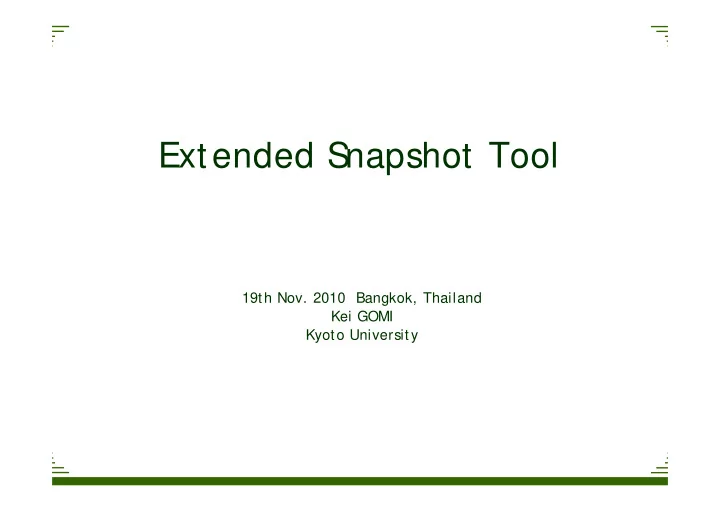

Extended S napshot Tool 19th Nov. 2010 Bangkok, Thailand Kei GOMI Kyoto University
What is ExS S ? • Extended S napshot Tool • A static model consists of simultaneous equations with about 6000 variables • GAMS program • Describe S ocio-economic activity, energy consumption and CO2 emissions quantitatively and consistently • Determine introduction of Low-carbon measures required to achieve certain level of emission target • Extendable to Agriculture, Forestry, Land-use change, Waste disposal, Air/ Water Pollution, etc. 2
3
Necessary information • Base year data – Population and Household – Input Output table (or, regional economic accounting) – Transport demand (Passenger & Freight) – Building – Energy demand – Energy supply – etc • Reference for future scenario – Population proj ection – Economic proj ection / planning – Transport planning – Energy strategy – Potential of renewable energy – etc 4
ExS S Demo Version • S implified version of ExS S • S imilar structure with full version • An Excel file • For demonstration and training 5
S tructure of ExS S Demo Version Annual per capita GDP Population Base year Base year GDP growth rate growth rate population GDP Population S hare of industry Household size GDP of GDP of tertiary Number of primary/ second industry household ary industry Floor area per value added Commercial Freight Passenger Trip per person building floor transport transport Average trip distance area demand demand Energy service demand Modal share per driving force Energy service Freight generation per demand Fuel share Energy end-use device output Energy efficiency share Transport distance Energy end-use device Final energy demand Modal share energy efficiency Energy demand Central power Energy efficiency (CPG) (DPG) generation (CPG) Dispersed power Fuel share (CPG) generation (DPG) Energy demand Energy efficiency DPG Transmission loss (CPG) (CPG) Own use (CPG) Primary energy Exogenous variables Endogenous supply Parameters variables CO 2 emission factor CO 2 emssions 6 6
Four S teps • Area (1) • Base year • Demography Setting framework • Target year • Economy • Scenario name • Transport • LCS target • Building • Unit • Energy demand • Classification • Energy efficiency (2) • Power supply Input base year information • Emission factor (3) Estimate future • Population growth socio-economic scenario • Household size • Residential and “BaU” emissions • GDP growth • Commercial • Industrial structure • Industry • Transport demand • Passenger and freight Transport (4) Setting low-carbon • Power supply measures and • Carbon sink analyzing the result 7
Today, • Using ExS S Demo Version • With Thailand data • Input parameters based on socio-economic assumptions • Estimate BaU (business as usual) emissions • Try to achieve an emission target • Q&A 8
Recommend
More recommend